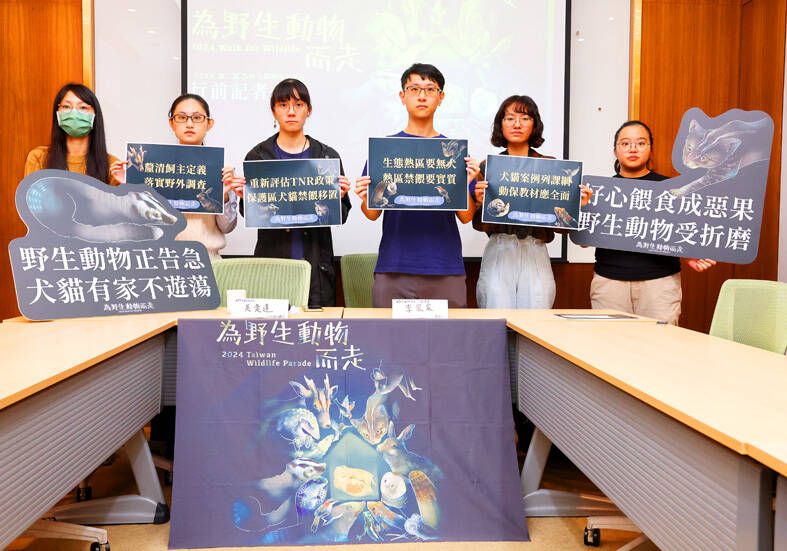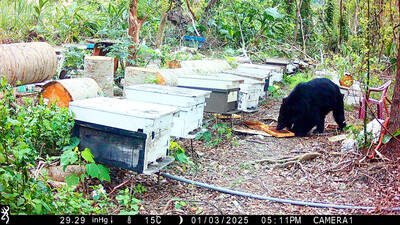A march calling on Taiwanese society to safeguard wildlife and ecological sustainability by reining in stray animals is to be held in Taipei tomorrow, the Walk for Wildlife Alliance said yesterday.
The Walk for Wildlife Alliance is hoping to reduce the total number of stray dogs and cats, strengthen the management of stray dogs, particularly in ecological hotspots, and raise public awareness about wildlife conservation, Wu Yi-ta (吳奕達), the march’s general coordinator, told a news conference.
The government has invested more than NT$300 million (US$9.33 million) in managing and reducing stray animals to date, but data from the past few years show that the number of stray dogs continues to rise, with 159,697 recorded in 2022, Wu said.

Photo: CNA
“Stray cats also cause significant damage to the environment, yet there is no investigative data on them in Taiwan,” Wu added.
The increasing number of stray animals poses a significant threat to wildlife, especially endangered species in ecological hotspots, Wu said, adding that about 25 percent of leopard cats released into the wild eventually die due to dog attacks.
In terms of public awareness, alliance founder Lee Tsung-chen (李宗宸) said that domestic dogs and cats have been listed as invasive species in Taiwan since 2022, but none of the textbooks in Taiwan address their ecological impact.
“We hope that by including such examples in the school curriculum, members of society will understand the ecological damage that can result from abandoning dogs and cats,” he said.
Lee hoped this idea could be adopted to better educate the public and help prevent pet abandonment or the release of pets into the wild.
Following the march’s debut last year that drew about 4,000 people, Wu said that the alliance expects more people to join the event this year, as there is “growing public attention” on issues related to wildlife conservation.
He also hopes it would have more of an impact than the first march last year, which focused on the conflict between invasive species — primarily domestic dogs and cats — and wildlife.
The Ministry of Agriculture responded to that march by launching a three-month pilot project aimed at protecting leopard cats by relocating stray dogs from ecological hotspots, but the alliance said it had disappointing results.
Tomorrow’s march is to start at 1:30pm outside the Legislative Yuan, loop around nearby streets and return by 2:30pm.
It is to feature a conservation-themed market, and exhibitions and talks would be held throughout the afternoon, the organizer said.
On Wednesday, the Ministry of Agriculture said it was already working to solve the issues called out by the alliance.
The key problem is the limited capacity of local governments to implement wildlife protection measures in biodiversity hotspots, Department of Animal Welfare Deputy Director Chen Chung-hsing (陳中興) said.
The ministry, which opposes feeding all animals in the wild, is working with local governments to promote feeding bans in these hotspots. However, since “biodiversity hotspot” is not a legal term, governments must impose fines on feeding based on the Waste Disposal Act (廢棄物清理法), he said.
The ministry has also helped local governments increase space for stray dogs, Forestry and Nature Conservation Agency Director-General Lin Hwa-ching (林華慶) said.
“The issue must be tackled systematically, with efforts from multiple angles, and different organizations must reach a consensus to resolve the issue,” Lin said.

SHIPS, TRAINS AND AUTOMOBILES: The ministry has announced changes to varied transportation industries taking effect soon, with a number of effects for passengers Beginning next month, the post office is canceling signature upon delivery and written inquiry services for international registered small packets in accordance with the new policy of the Universal Postal Union, the Ministry of Transportation and Communications said yesterday. The new policy does not apply to packets that are to be delivered to China, the ministry said. Senders of international registered small packets would receive a NT$10 rebate on postage if the packets are sent from Jan. 1 to March 31, it added. The ministry said that three other policies are also scheduled to take effect next month. International cruise ship operators

NUMBERS IMBALANCE: More than 4 million Taiwanese have visited China this year, while only about half a million Chinese have visited here Beijing has yet to respond to Taiwan’s requests for negotiation over matters related to the recovery of cross-strait tourism, the Tourism Administration said yesterday. Taiwan’s tourism authority issued the statement after Chinese-language daily the China Times reported yesterday that the government’s policy of banning group tours to China does not stop Taiwanese from visiting the country. As of October, more than 4.2 million had traveled to China this year, exceeding last year. Beijing estimated the number of Taiwanese tourists in China could reach 4.5 million this year. By contrast, only 500,000 Chinese tourists are expected in Taiwan, the report said. The report

The Forestry and Nature Conservation Agency yesterday launched a gift box to market honey “certified by a Formosan black bear” in appreciation of a beekeeper’s amicable interaction with a honey-thieving bear. Beekeeper Chih Ming-chen (池明鎮) in January inspected his bee farm in Hualien County’s Jhuosi Township (卓溪) and found that more than 20 beehives had been destroyed and many hives were eaten, with bear droppings and paw prints near the destroyed hives, the agency said. Chih returned to the farm to move the remaining beehives away that evening when he encountered a Formosan black bear only 20m away, the agency said. The bear

Chinese embassy staffers attempted to interrupt an award ceremony of an international tea competition in France when the organizer introduced Taiwan and displayed the Republic of China flag, a Taiwanese tea farmer said in an interview published today. Hsieh Chung-lin (謝忠霖), chief executive of Juxin Tea Factory from Taichung's Lishan (梨山) area, on Dec. 2 attended the Teas of the World International Contest held at the Peruvian embassy in Paris. Hsieh was awarded a special prize for his Huagang Snow Source Tea by the nonprofit Agency for the Valorization of Agricultural Products (AVPA). During the ceremony, two Chinese embassy staffers in attendance